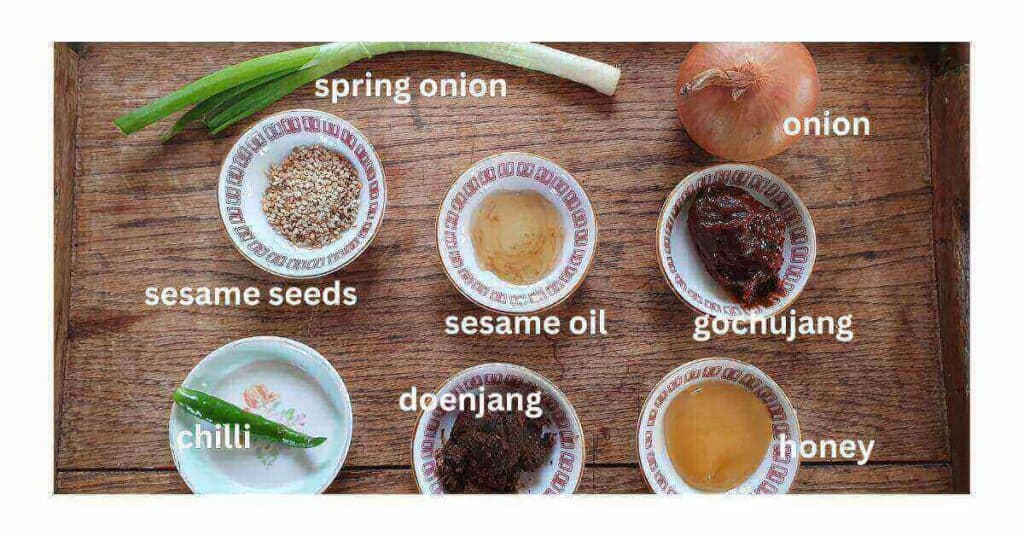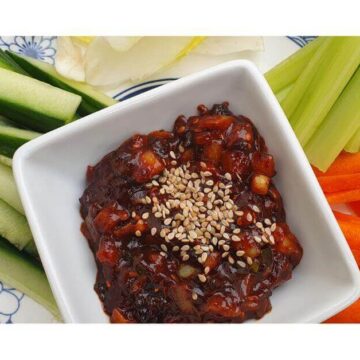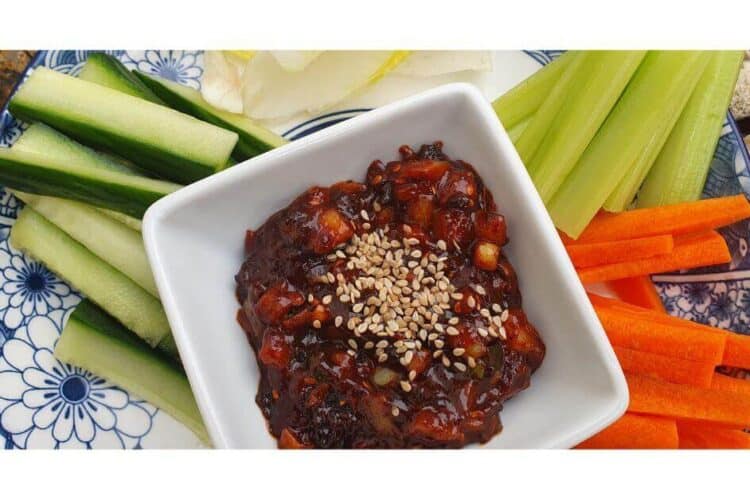Last updated on August 26th, 2024 at 12:52 pm
Ssamjang is a Korean dip which is spicy, salty, savory and sweet and made from a combination of gochujang, doenjang, aromatics, sesame oil, sesame seeds and honey.
Ssamjang means wrap sauce. One has to learn different types of sauces and dips to go along with different dishes and make some inspired by places and restaurants, and with the help of the Internet, it is becoming easier to find recipes and tweak them as needed and come up with a desired jang or sauce.
Like many sauces that I have learned to make, I try to remember what they tasted like when I had them from my travels.
This dip is no different, although there are recipes available online there are differences in the saltiness or spiciness of ingredients available and I will have to find the right balance and or satisfy or tick the boxes based on how I remember them.
This recipe is not an authentic Korean recipe but based on experience and recipes available using ingredients on hand.
Have you had ssamjang before and tried to recreate it?
Tubs of ssamjang could be bought in stores but if it is this easy to make one which will last long in the fridge minus the fresh ingredients of course would make you or me enjoy our meals more knowing what is in it.
When made from scratch this dip is completely customizable, making it sweeter, spicier or saltier.
We do not need many reasons why we need to make dips and sauces at home. Let’s get cooking.
When you would make ssamjang?
This is served as a sauce or dip for vegetables and wraps.
Usually served alongside vegetables mainly lettuce wraps at a Korean place, a barbeque place that is.
Ssamjang brings savory, sweetness and spice that elevates the flavor of the meal. It brings balance to the fattiness of protein.
Ingredients

Gochujang and doenjang are available from physical Asian stores or online. The rest of the ingredients would be easily found in a Western supermarket. Before you know it you have a tub of each major sauce and you would be able to make ssamjang in no time.
Recipes of Maangchi and Seonkyeong Longest both add garlic to their jang but I have gotten used to only using spring onion and onion.
Gochujang – Korean red chilli paste
Doenjang – fermented soy bean paste
Sesame oil – Korean toasted sesame oil is preferred for its nutty and toasted flavor but sometimes other toasted sesame oil made for home cooks like me to work too
Honey – serves as a sweetener, syrup and sugar work as well
Spring onion – adds texture to the sauce
Chopped onion – same as above that it adds an element of texture
Green chilli – adds heat, use more if you want it hot
Toasted sesame seeds – toast them at home would be best, this brings the nuttiness of the seeds more
How to make Sssamjang?
1. Mince the spring onion, onion and chilli. You want that crunch but not chunks.
2. Mix the gochujang and doenjang pastes, sesame oil and honey in a bowl. This is the time to customize, and add more of ingredients depending on your taste. If you like it sweeter add more honey, spice or check for saltiness.
3. When satisfied with the consistency and flavor, add all the aromatics and sesame seeds.
4. Mix then transfer to a serving bowl and sprinkle some sesame seeds over the top.
How to serve Ssamjang
It is commonly served in a bowl alongside grilled meats but also as a dip for fresh vegetables and as a wrap sauce.
Storage
Leave the fresh ingredients out and keep the sauce in an airtight container. It will keep in the fridge for a long time.
Frequently Asked Questions
What do you use ssamjang for?
A dip for freshly cut vegetables and also a condiment to add to wrap with barbequed protein, rice and vegetables.
Maangchi and Daniel of Future Dish both said to grab a lettuce leaf, top it with rice and dab some ssamjang and it is already great even without protein.
What does ssamjang taste like?
It is a seasoned dip that is savory, sweet, spicy and salty.
What do Koreans eat with ssamjang?
It is used as a condiment and also a marinade. Aaron and Claire have three ways to use ssamjang not only as an accompaniment or a dip.
How to use dried-out doenjang?
We all occasionally forget to keep pastes in airtight containers which dries them up.
If this happens, check for any rotten smell and any suspicious activity going on in a tub of doenjang and if there is none like the doenjang used in this recipe, use it as it is.
Here is an interesting thread from reddit about dried-out doenjang paste.
It’s your turn to try and make this ssamajang recipe at home. If you make it, we would love to hear from you about how you find this dish.
Feeling more adventurous or out of ideas? Why not try some more sauces and condiments inspired by Japanese, Filipino and Indian cuisine like Filipino spiced vinegar, homemade tonkatsu sauce, raita or soy sauce vinegar sauce.
Hungry for more or looking for inspiration? Browse more recipes here or head to Facebook, Pinterest and Instagram for updates on life in the countryside and beyond.

Homemade Ssamjang
Ingredients
- 1 tbsp gochujang
- 1 tbsp doenjang
- 1/2 tsp sesame oil
- 1/2 tsp honey
- 1 stalk spring onion minced
- 1 small onion minced
- 1 chilli green
- 1 tsp toasted sesame seeds
Instructions
- Mince the spring onion, onion and chilli.
- Mix the gochujang and doenjang pastes, sesame oil and honey in a bowl.
- When satisfied with the consistency and flavor, add all the aromatics and sesame seeds.
- Mix then transfer to a serving bowl and sprinkle some sesame seeds over the top.


